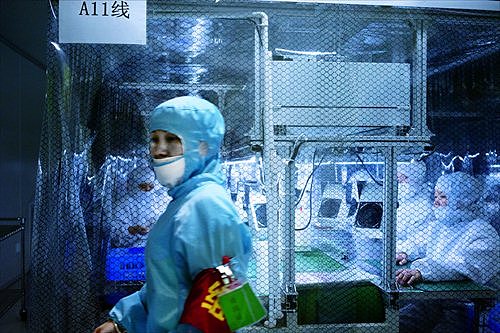‘World’s factory’ maintains advantages at keeping high-end manufacturing in country Go back »
2015-07-29 | All chapters

Making it in China
China has a problem. Much of the country's low-cost, low-skilled manufacturing, especially in South China's Guangdong Province, has been relocating to Southeast Asia to take advantage of cheaper labor costs. The trend threatens one of the major sources of China's economic growth over the last few decades. Not all is lost, however. Although low-end manufacturing is leaving, China maintains other advantages that have allowed its high-tech manufacturing to flourish. At the same time, the central government's "Made in China 2025" initiative offers another chance to keep high-tech manufacturing in China. On a recent visit to Shenzhen, Guangdong Province, Global Times reporter found out why high-tech companies in the factory province are staying.
While maintaining a factory in Huizhou, South China's Guangdong Province, Italian synthetic leather producer Coronet Spa has been considering investing about $10 million to expand its production lines in Vietnam over the next three years, Jarno Tagliarini, the company's CEO, told the Global Times Monday.
"We've decided to move to Vietnam in order to keep service stable for them [our clients]," Tagliarini said.
The CEO explained that some of its clients had already moved to Southeast Asia. And because the company sits in the middle of a supply chain for branded shoes and bags, its executives believed they had no other choice than to shift some of the company's manufacturing to the region.
Coronet Spa is not the only manufacturer that has opened factories in countries like Vietnam and Indonesia, said Alberto Vettoretti, managing partner of the professional services firm Dezan Shira & Associates in Shenzhen.
Manufacturers have been looking for alternative production bases in Asia for several reasons, including lower tax rates and a sustainable supply of lower-cost workers, Vettoretti told the Global Times on July 22.
Labor costs
From made-in-China to made-in-Vietnam labels, customers are aware that footwear companies such as Nike Inc and Adidas AG have been relocating their facilities to Southeast Asia in search of lower costs.
"It's an ongoing trend in the manufacturing sector," Ma Nan, analyst from Beijing-based China Investment Consulting told the Global Times Tuesday.
There are some clear reasons for the shift. Because China's population has been aging rapidly, fewer young workers have been entering the workforce, effectively reducing the supply in the labor market.
In addition, nominal wages have been growing faster than productivity, which has been pushing up labor costs, Ma said.
At Shenzhen Million Best Optoelectronics Co, a light-emitting diode (LED) backlight manufacturer in Shenzhen, more than 30 percent of the company's employees earn about 5,700 yuan ($917.80) a month, said Li Sishen, the company's general manager.
Li said the company will continue to raise workers salaries as average wages in Shenzhen are higher than in other cities in Guangdong.
The average monthly salary in Shenzhen was 7,261 yuan in 2014, the highest in Guangdong, media reported in January. Wages for production-line workers have increased 15 percent from 2013 to 2014, the Guangzhou-based Yangcheng Evening News reported in February.
While overall labor costs continuing to rise, manufacturers in China will have harder time finding experienced and skilled workers over the next few years, said Vettoretti, who also chairs the European Union Chamber of Commerce South China Chapter.
High-tech versus labor-intensive
Despite rising labor costs and shortage of talent with engineering and technical skills in the region, Foxconn Technology Group, a contract manufacturer for companies like Apple Inc, is planning to keep its operations in China, according to a person close to the matter who refused to be named.
"The company has developed a sustainable supply chain here, which is crucial for Foxconn's future development," he told the Global Times on July 23.
Leaving the region, he said, "it would not be a smart choice."
Unlike labor-intensive industries like shoe manufacturing, high-tech companies such as Foxconn have other factors to consider, said Ma from China Investment Consulting.
Because electronics and IT products are such as large part of Shenzhen's manufacturing sector, high-tech companies have access to a large and robust supply chain of electronic component makers. "High-tech companies here can find all different kinds of suppliers of certain electronic product - LED backlights, for example," said Li from Shenzhen Million Best Optoelectronics.
He noted that high-tech companies would be unwilling to move to Southeast Asia because the supply chains in countries like Vietnam and Indonesia aren't as good as China's.
Upgraded production
After the State Council, China's cabinet, unveiled a 10-year plan "Made in China 2025" in May to upgrade the country's manufacturing sector by encouraging innovation and optimization, manufacturers in Shenzhen have been highlighting priority sectors such as automated machine tools.
Since the plan was announced, giant electronics manufacturers and private small and medium-sized companies in Shenzhen have been working on advanced technologies for production lines.
Foxconn is pushing forward its automation technology as a way to offset labor costs and improve manufacturing, Chia-Peng Day, general manager of the company's automation technology development committee, told the Global Times on July 23.
"Robots were not designed to completely replace human workers. However, robots can be employed to do dangerous and less skilled work, and to improve productivity," Day said.
Dozens of robots were monitored for tests in Foxconn's Longhua campus in Shenzhen. Those robots are expected to be used for various tasks such as stamping and polishing, Day said. Still, they can't do everything. "Assembly remains a major challenge for the robots, so better solutions will be needed," he said.
Li from Shenzhen Million Best Optoelectronics Co told the Global Times on July 24 that the company recently purchased a private company specialized in automated technology.
"We've just installed automated machinery, which has freed some workers from simple but repetitive work," he said.
Source: Global Times